Hydraulic hose fittings are components used in hydraulic systems to connect hoses, pipes, and tubes. It is critical to select the proper hydraulic hose fitting in order to maintain seal quality, and hose pressure, and reduce the risk of torque. There is a wide variety of hydraulic hose fittings available online, and we have created this guide to assist you in selecting the correct fittings for your needs.
Important Factors to Consider Before Buying
Sizing – Selecting the proper size is critical for optimal functionality. The size of a hydraulic fitting is determined by the size of the vessels to which it is connected. The inside diameter (ID) and outside diameter (OD) of tubes, hoses, and pipes are measured in inches (in) or millimeters (mm). If the fitting is too large or too small, it will not connect or seal properly, affecting the hose's performance.
Hose fittings are made from a variety of materials, including brass, aluminium, cast iron, steel, and plastics. Metals are more commonly used than plastics because high pressures require stronger materials. Choosing the right material is critical for preserving seal quality and hose pressure. The following is a breakdown of our materials:
Brass is a strong, long-lasting, and corrosion-resistant metal. Because of its machinability and excellent performance, the material is frequently used for smaller compression.
Aluminium has low tensile strength and is used because of its corrosion resistance and low density. However, due to its lack of strength, this material should not be preferred over brass for high-pressure hydraulic systems.
Steel is a strong and durable material with high heat resistance. To improve its low corrosion resistance, it is typically alloyed with other materials. Stainless steel has a higher corrosion resistance but is typically more expensive than materials such as brass and aluminium.
Choosing the right material for a hose fitting is critical for hydraulic systems to maintain hose performance. Although the metals have different advantages, brass is the most recommended material for hose fittings because it is an economical, affordable fitting with a strong and durable density. Brass fittings can be used in a variety of media, including but not limited to water, oil, and air, primarily in the hydraulic and pneumatic industries. Explore our extensive selection of brass fittings and brass hose tails.
When selecting a hydraulic hose fitting, consider the pressure rating. Hydraulic systems generate high pressure, which must be contained by the hose fitting to reduce the risk of torque. The maximum working pressure of the hose and the fitting component is rated for a hose assembly.
Hose fittings that fail can pose potential hazards to machine operators. Although they may appear to some to be minor, insignificant components of a hose system, they are an absolutely necessary fluid power transmitting component. Before making a purchase, consider the product's dependability. For many years, JIC fittings have been the industry standard and O rings are highly regarded due to their seal fittings, which reduce the risk of torque.
Hydraulic Fittings of Various Types
BSP – (British Standard Pipe) The BSP connection is similar to the National Pipe Straight Mechanical (NPSM) connection, with the exception that the thread pitches differ in most sizes. The BSP female swivel has a tapered nose/flareless swivel that seals on the male's cone seat. The dimensions of these fittings are in inches.
JIC- JIC (Joint Industry Council) fittings are widely used in the Fluid Power industry for diagnostic and test-point purposes, particularly when high pressure is involved.
Millimeters are used to measure the Metric L Series and Metric S Series. The size refers to the outside diameter unless otherwise specified.
ORFS – (O Ring Face Seal). In the face of the male fitting, there is a straight thread and an O-ring. The female has a straight thread and a flat face that has been machined. Similar to a split flange fitting, the seal is achieved by compressing the O-ring onto the flat face of the female. The threads mechanically secure the connection.
Selecting the Best Hose Fitting for Your Needs
Many factors influence hydraulic hose fitting performance and it is critical to consider these when selecting the right ones. Strict adherence to assembly procedures ensures a solid connection rather than a potential problem. If you need help deciding which hose fittings to buy, please contact us or browse our selection of hydraulic hose fittings.





